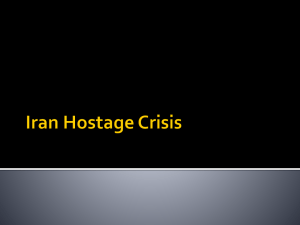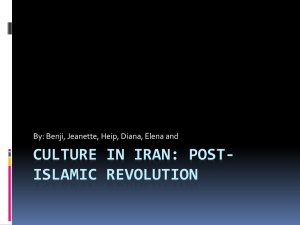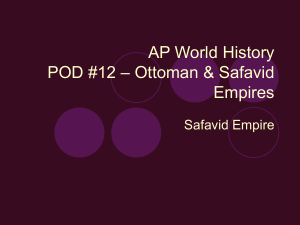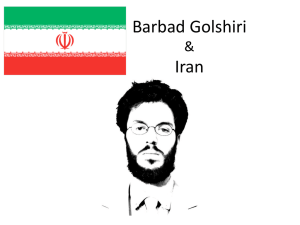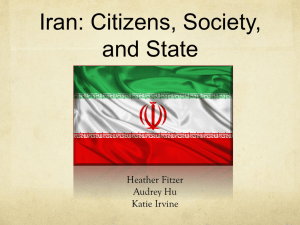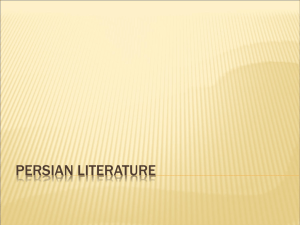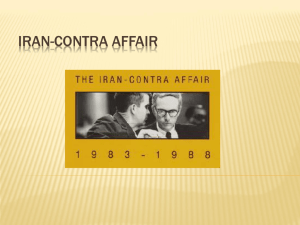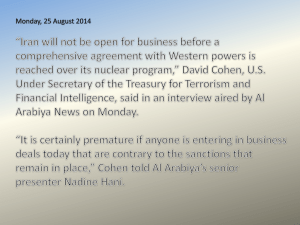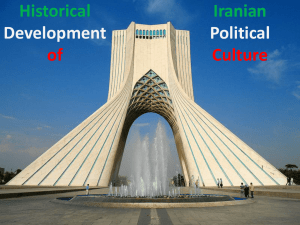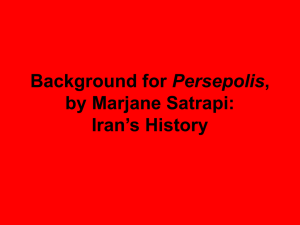Pre-Islamic Revolution Iranian Society
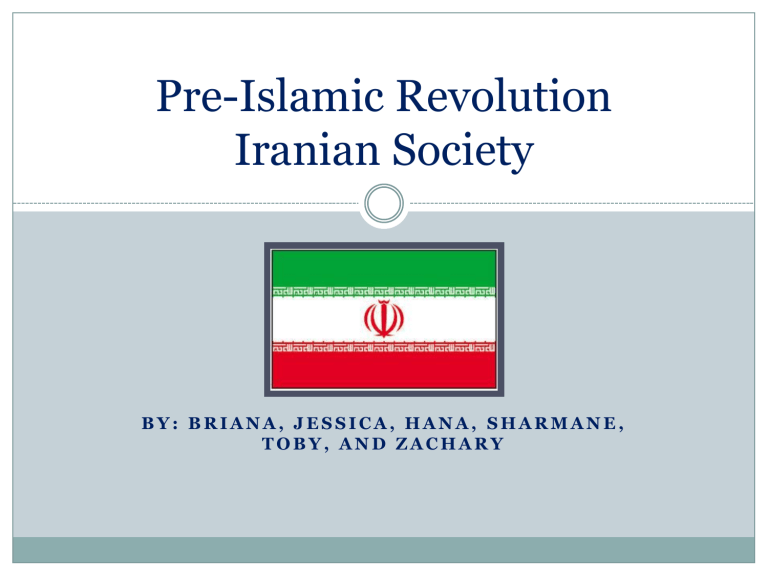
Pre-Islamic Revolution
Iranian Society
B Y : B R I A N A , J E S S I C A , H A N A , S H A R M A N E ,
T O B Y , A N D Z A C H A R Y
Pre-Islamic Revolution:
Religions in Iran
Zoroastrianism
Judaism Christianity
Islam
Fun fact: Pre-Islamic religions in Iran were all monotheistic, with
Zoroastrianism being credited with the concept of one god, heaven and hell that influenced the modern religions of Judaism, Christianity and Islam.
Pre-Revolutionary
Zoroastrianism
Zoroastrians date back to the Achaemenid Empire more than two thousand years ago.
Zoroasters were afforded reasonable treatment in pre-revolutionary
Iran by the Shah, but many emigrated to India to avoid persecution at the hands of fundamentalist Muslims
Many Zoroasters were forced to convert to Islam.
Pre-Revolutionary
Judaism
Iranian Jews claim to be the oldest continuous Jewish community in the world, dating back to the removal to Babylon.
Jews were afforded reasonable treatment in pre-revolutionary Iran by the Shah, but many emigrated to Israel to avoid persecution
Jews are credited with helping preserve much of Iran’s early musical and traditional celebrations
Pre-Revolutionary
Christianity
Armenians, an ancient Christian people, were imported by Iranian rulers for their artisan.
Assyrian Christians, who follow a non-Trinitarian doctrine, have been continually resident in Iran since the third century.
Christians, like many other non-Islamic religions have been persecuted, forcing many to leave Iran for the west.
Pre-Revolutionary
Islam
Characterized by secularization of Sharia law, where women were given liberties to participate fully in the Iranian economy and education.
Under the Shah, the attempt to Westernize Iranian society was given the name of the White Revolution
Nationalize forests, electoral reform to enfranchise women, privatization of state owned enterprises and profit sharing by the wealthy in industry
This Westernization was not fully supported by the Ulama, the educated class of Iranian Islamic scholars
Pre-Islamic Revolution:
Family Life in Iran
An Iranian family eating a meal in Shiraj. Even after they leave home, members of extended families have hospitality rights in the homes of their most distant relatives.
Pre-Revolutionary
Mother’s Roles
The role of the mother has always been extremely important in Iran. Mothers are expected to breast-feed their babies for fear the babies will become "remorseless.“
Iranian mothers and children are expected to be mutually supportive.
In Iran, mothers have always protected their children's reputations under all circumstances.
Parents are very committed to their children and they provide financial support even after their children marry.
Pre-Revolutionary
Father’s Roles
Iranian fathers are the disciplinarians of their families.
In Iran, fathers can become fierce and stern as children approach puberty.
It is an Iranian father's responsibility to protect the honor of his family, and this means keeping close watch on the women and their activities.
The relationship between parents and their children is more important than the parents marriage
Pre-Revolutionary
Children’s Roles
Older children often raise younger children, especially in rural settings.
Children are usually very willing to help raise younger kids, and develop strong bonds with their siblings.
Sibling rivalry is quite common.
Children respect elderly.
Iranians live with their parents until married (regardless of age)
The rule of primogeniture is strong, and older children have the right to discipline younger children.
Pre-Islamic Revolution:
Family Life
Family is highly valued and relatives are close.
Elderly are respected and cared for by younger family members.
Boys are traditionally preferred.
Pre-Islamic Revolution:
Family Life
Patriarchal
Large families with many children
A man can have up to four wives but most men prefer one wife
Parents provide financial support for children even after they are married
People live with their parents until marriage
The relationship between parents and children is more important than between husband and wife
Pre-Islamic Revolution:
Gender Roles and Rights in Iran
Iranian university students in the 1970's Pre Islam Arab Women 4th to 6th century C.E.
Iranian woman supporting equality between men and women
Pre-Islamic Charter of Human Rights:
The Cyrus
Cylinder
The Cyrus Cylinder is a small 6 th century BC clay object that tells the story of the ancient Persian emperor Cyrus's conquest of Babylon.
Pre-Islamic Revolution Iranians see the cylinder as the first charter of human rights with a message of freedom of conscience far ahead of its time.
Emperor Cyrus’s tolerance earned him the reverence of exiled Babylonian Jews, whose temple in Jerusalem he subsequently restored, according to Biblical accounts.
Today, many Iranian political figures discount Iran’s pre-Islamic legacy, and since the 1979 Islamic revolution that brought them to power, they have attempted to abolish the artifacts of that early tradition:
Banning pre-Islamic holidays
Destroying the archeological record of Persepolis, the ceremonial capital of Cyrus's dynasty
Pre-Revolutionary
Women’s Rights and Roles
Women made up more than 50% of Iranian University students, and could attend universities as of 1937.
Many women practiced with the use of veils when they were in public, and around men not related to them at home.
Iranian women were given the right to vote in 1963.
The minimum marriage age for women was set at 15, and women were allowed to include the right to divorce in their marriage contracts.
Many women often held jobs that were outside the official labor sphere, more 'feminine' jobs, such as domestic servants, and self-employed vendors.
Pre-Revolutionary
Men’s Rights and Roles
Men’s statuses were based upon wealth.
Some believed that men held power over their households, children, and the less fortunate.
Men are allowed to have up to four wives as long as they provide equally for all of them.
Pre-Islamic Revolution:
Education
Public school – Free
Parents enroll their children at age 6
Elementary – 5 years
Junior High – 3 years
Pre-Revolutionary
Education
Senior High – 3 years
Pre-university Education – 1 year
Language of Instruction – Farsi
Large network of private and public universities
Pre-Revolutionary
Education
Females over 9 years old had to be covered in a traditional veil
Pre-Revolutionary
Learning Opportunities
Prior to Islamic Revolution, educational opportunities were increasing.
There were big gains in the number of people who went to school, but still disparity between males and females and between urban and rural areas.
Mixed gender, coed schools were common.
Pre-Revolutionary
Textbooks
Shah was trying to modernize schools – used textbooks directly translated from French that showed people in western dress.
Social studies textbooks covered a lot about the
Shah, his wife and his son
Social studies textbooks also covered the United
Nations Declaration on Human Rights
Pre-Islamic Revolution:
Economy
Iranian currency is called rial.
Pre-Revolutionary
Impact of Oil on Economy
• Oil played an important role in shaping Iran’s economy
Iranian oil pipelines
Iranian oil well
Pre-Revolutionary
Impact of Oil on Economy
• Oil was and is Iran’s biggest export
• Oil is used to make gasoline as well as other items such as plastics, detergents and more
• Because of oil, Iran transformed from a traditional agricultural society to a largely industrialized and modernized country
Pre-Islamic Revolution:
Economic Conditions Leading Up to the Islamic Revolution
During the decades before the Islamic Revolution, Iran’s economy grew significantly
In the 1970s, oil prices rose dramatically, because of worldwide demand
The economy was already declining before the Islamic Revolution began in 1979
By 1978, just before the Islamic Revolution, economic growth slowed dramatically
Pre-Islamic Revolution:
Socioeconomics
Persian is the prevalent ethnicity in Iran, making up around 61% of the population
Other ethnicities include: Azeri 16%, Kurd 10%, Lur
6%, Baloch 2%, Arab 2%, Turkmen and Turkic tribes
2%, other 1%
Pre-Revolutionary
Religion
Islam is the official religion of Iran, and 98% of people practice it
Muslims in Iran are divided between two major sects: the Shia and the Sunni. The Shia sect has the majority of people, with 89% compared to the 9% of the Sunni
Other religions include Christianity, Judaism, and
Zoroastrianism
Pre-Revolutionary
Languages
Persian is the official language of Iran, with 53% of people speaking it.
Other languages Include:Azeri Turkic and Turkic dialects 18%, Kurdish 10%, Gilaki and Mazandarani
7%, Luri 6%, Balochi 2%, Arabic 2%, other 2%
Bibliography
Beeman, William O. "Countries and Their Cultures." Culture of Iran. Advameg, Inc, 2013. Web. 24 Sept. 2013.
Morita, Toyoko. "Islam, Education, and Human Rights in Iran." Asian-Pacific Human Rights Information
Center. Asian-Pacific Human Rights Information Center, n.d. Web. 24 Sept. 2013.
Price, Massoume. "Iran Chamber Society: Iranian Society: Patriarchy and Parental Control in Iran." Iran
Chamber Society: Iranian Society: Patriarchy and Parental Control in Iran. N.p., Mar. 2006. Web. 24 Sept.
2013.
Price, Massoume. "::| Culture of IRAN |:: Patriarchy and Parental Control in Iran." ::| Culture of IRAN |::
Patriarchy and Parental Control in Iran. Aesthetic Design Studios, Oct. 2009. Web. 24 Sept. 2013.
Maloney, Suzanne. "The Iran Primer." The Revolutionary Economy. United States Institute of Peace or the
Woodrow Wilson International Center for Scholars, n.d. Web. 24 Sept. 2013.
"Iran: Economy." GlobalEDGE: Your Source for Global Business Knowledge. Michigan State University, n.d.
Web. 24 Sept. 2013.
Iran." CultureGrams Online Edition. ProQuest, 2013. Web. 24 Sep 2013.
Anvari, Haleh. "Iran Then and Now." The Guardian. N.p., 24 Sept. 2001. Web. 24 Sept. 2013.
<http://www.theguardian.com/world/2001/sep/25/afghanistan.terrorism25>.
Central Intelligence Agency, CIA. “Middle east: Iran." The World Factbook. CIA, n.d. Web. 24 Sept. 2013.
<https://www.cia.gov/library/publications/the-world-factbook/geos/ir.html>.
United Nations, UN. "United Nations Statistics Division - Demographic and Social Statistics." United Nations
Statistics Division - Demographic and Social Statistics. UN, n.d. Web. 24 Sept. 2013.
<http://unstats.un.org/unsd/demographic/products/dyb/dyb2.htm>.
United Nations, UN. "World Population Prospects, the 2012 Revision." World Population Prospects, the 2012
Revision. UN, n.d. Web. 24 Sept. 2013. <http://esa.un.org/unpd/wpp/index.htm>.

